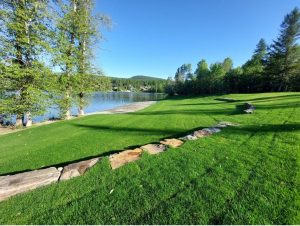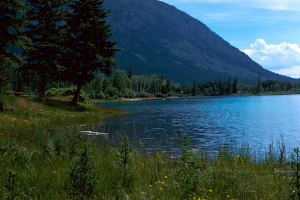In fall of 2023, students from Dr. Nicholas Kinar’s GEOG 211 – Introduction to Geographic Information Systems wrote a blog post as part of their course requirements. Their focus was on accessibility in BC Parks for College students, but we think it is valuable information for everyone, and wanted to share. The authors of the following are Gala, Jessie, and Rae.
At College of the Rockies (COTR) we are fortunate to be surrounded by the breathtaking landscapes of the East Kootenay. The abundant wildlife, pristine freshwater, and soaring mountains are some of the key features of our province that many of us may take for granted. This natural abundance not only enriches our post-secondary experience at COTR but also significantly contributes to a positive mood and overall well-being on campus.
Connecting with nature is not just a recreational activity; it is also a vital aspect of overall well-being that is recognized for its ability to improve mental and emotional well-being (Jimenez et al., 2021).

The connection to nature has been shown to improve mental health, lower blood pressure, and even enhance cognitive function (Jimenez, 2021). Demonstrated benefits of this connection encompass improved mental health, reduced blood pressure, and heightened cognitive function (Jimenez, 2021). Furthermore, outdoor exposure is recognized as a potent therapeutic intervention for addressing attention deficits and behavioural conditions (Jimenez, 2021). This underscores the significance of COTR students venturing outdoors and immersing themselves in nature.
Access to Nature is a Fundamental Human Need:
While College of the Rockies is blessed with proximity to stunning BC Park locations, the true value of this resource lies in its accessibility to these spaces. Addressing accessibility requirements includes looking at a wide range of visible and invisible obstacles.
Financial Barriers
Financial constraints pose significant hurdles for individuals wishing to engage with the outdoors. This includes limitations in accessing correct equipment or services that enhance the outdoor experience, particularly for those with mobility disabilities. Some may find themselves restricted by the cost of campsite fees or transportation, or even by the expenses associated with purchasing outdoor gear.
Physical Barriers

Individuals with mobility concerns face challenges in experiencing the beauty of the backcountry due to physical obstacles. These may include the absence of walkable trails, wheelchair-access, or a lack of amenities designed to accommodate health and hygiene needs. Additionally, individuals with visual impairments face unique challenges, as traditional trail systems often lack features like adaptable maps, tactile guides, or audible cues.
Cultural Barriers
Cultural background plays a pivotal role in shaping an individual’s comfort level and interest in engaging with the outdoors. Recognizing and respecting diverse cultural perspectives on outdoor activities is paramount. For instance, First Nations communities have deep-rooted connections with the land, and their ability to access traditional spaces has been adversely affected by historical colonial practices.
Creating an environment that embraces and celebrates diversity is fundamental to fostering an inclusive outdoor community. By acknowledging and addressing historical injustices and promoting cultural sensitivity, we can ensure that everyone, regardless of background, feels welcome and valued in the great outdoors.
The Significance of Mapping in Accessibility:
A well-crafted map becomes a compass, guiding individuals towards paths that cater to their unique needs. A visual guide becomes a tool of inclusivity, ensuring that outdoor spaces are accessible to everyone. Ultimately, the significance of mapping lies in its ability to empower, connect, and open doors to for individuals of all abilities.
The Accessibility Map
Understanding that accessibility to outdoor spaces is vital for well-being, we’ve taken a step towards making this connection even more seamless. Driven by a commitment to inclusivity, our team has utilized GIS technology to create an Accessibility Map of some of the closest BC Parks sites to College of the Rockies. This visual guide specifically highlights key features at BC Parks such as “All Vehicle Access” locations or the presence of bathrooms on site. This map is designed to serve as a user-friendly tool, ensuring that everyone, regardless of ability, can enjoy the great outdoors.
This map serves as a testament to our belief that everyone, regardless of ability, should have the opportunity to enjoy the outdoors. By pinpointing specific parks near COTR’s Cranbrook campus and addressing potential obstacles—be they financial, physical, or cultural—we are dedicated to ensuring that the beauty of nature remains accessible to every individual. More than just a visual guide, it embodies our commitment to the idea that everyone deserves the chance to connect with the outdoors, fostering a sense of well-being and inclusion within our college community.
BC Parks’ Commitment to Change
Fortunately, BC Parks is actively working to enhance accessibility through ongoing adjustments to its park programming. Many locations now feature accessible trails, ramps, and bathrooms, ensuring that individuals of all physical abilities can enjoy the experience (Parks’, n.d.). To further eliminate financial barriers, BC Parks offers free camping to visitors with disabilities who are on income assistance (Parks’, n.d.). The commitment to positive change extends beyond infrastructure improvements; BC Parks strives to incorporate cultural connections and diverse perspectives into its programming. This includes a focus on acknowledging cultural ties to the land within provincial parks and moving away from colonial viewpoints (Parks’, n.d.). These progressive changes within BC Parks reflect a dedicated effort towards inclusivity and positive transformation. For more information you can visit the official BC Parks website.
References
Jimenez, M. P., DeVille, N. V., Elliott, E. G., Schiff, J. E., Wilt, G. E., Hart, J. E., & James, P. (2021). Associations between Nature Exposure and Health: A Review of the Evidence. International Journal of Environmental Research and Public Health, 18(9), 4790. https://doi.org/10.3390/ijerph18094790
Jimsmith Lake Park. (n.d.). BC Parks. Retrieved December 4, 2023, from https://bcparks.ca/jimsmith-lake-park/
Norbury Lake Park. (n.d.). BC Parks. Retrieved December 4, 2023, from https://bcparks.ca/norbury-lake-park/
Parks’, B. (n.d.). Commitment to Inclusion | BC Parks. Bcparks.Ca. Retrieved December 4, 2023, from https://bcparks.ca/about/commitment-to-inclusion/#page-section-642
Thompson, L. (2022, November 14). Skating on frozen lakes. Cranbrooktourism.Com. https://cranbrooktourism.com/blog/skating-on-frozen-lakes
